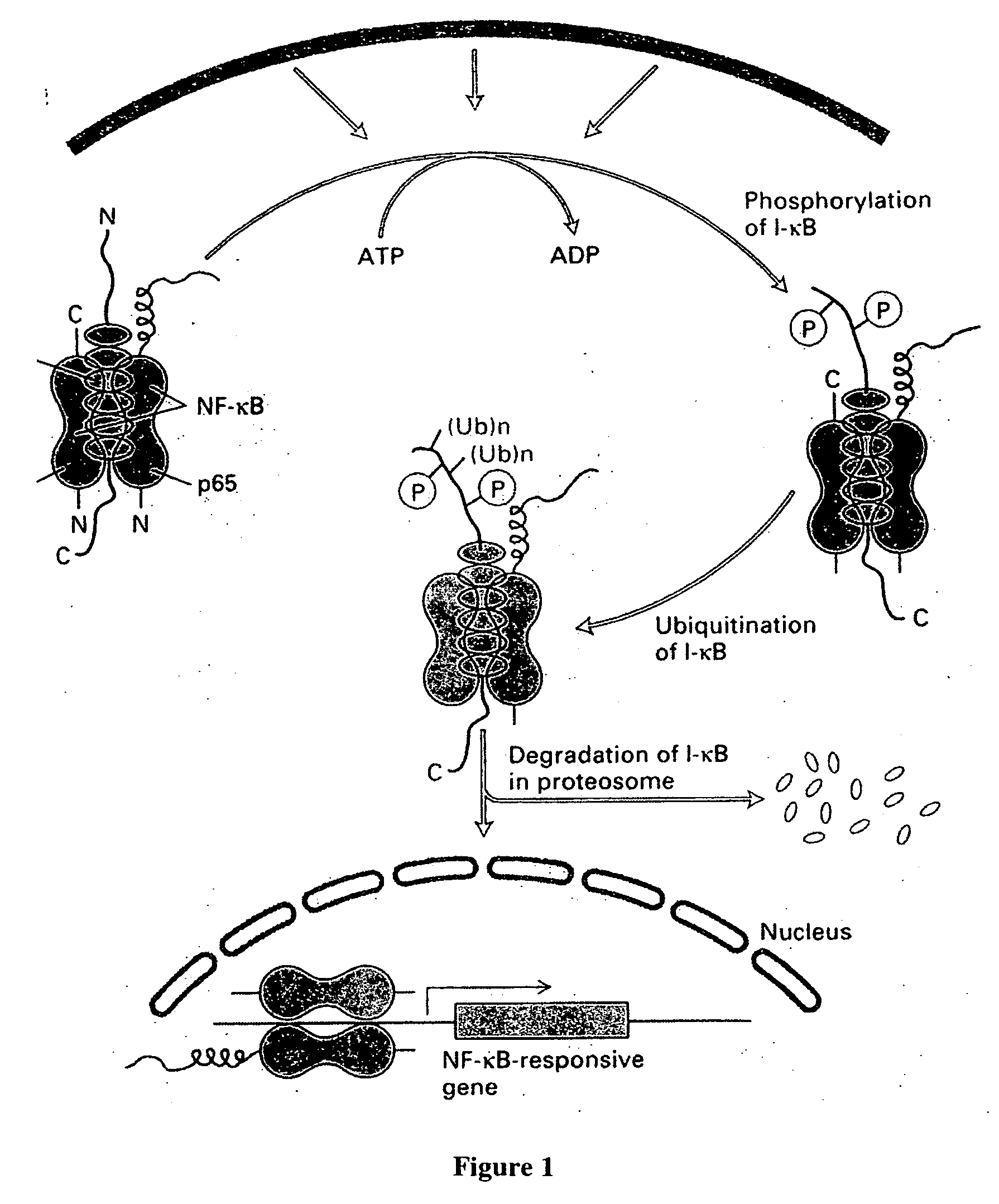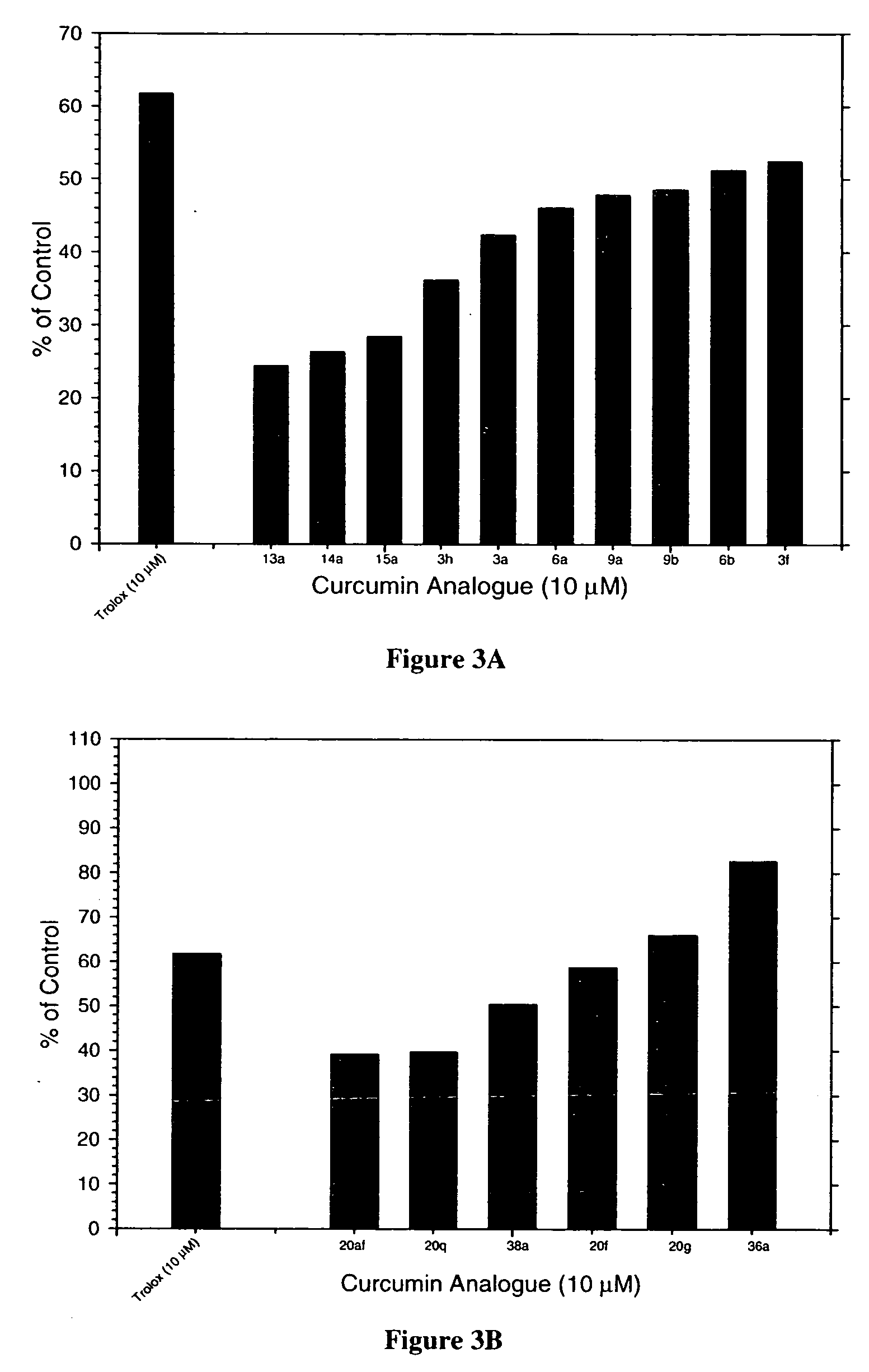Cancer treatment using curcumin derivatives
a technology of curcumin and derivatives, applied in the direction of biocide, anhydride/acid/halide active ingredients, instruments, etc., can solve the problems of precancerous growth or cancer, and achieve the effect of lowering ap-1 activation and lowering ap-1 activation
- Summary
- Abstract
- Description
- Claims
- Application Information
AI Technical Summary
Benefits of technology
Problems solved by technology
Method used
Image
Examples
examples of 7-c
Linkers
[0123] Table 1 shows a number of examples of curcumin derivatives that include a seven carbon linker. The compounds shown contain two aryl rings separated by a seven carbon spacer having two carbonyls (or the equivalent keto-enol tautomer). In many, but not all, of the compounds, the spacer is unsaturated.
TABLE 17-Carbon Linker Analogs. 3a 3b 3c 3d 3e 3f 3g 3h 3i 6a 6b 9a 9b11b12b13a13b14a14b15a15b16b17b
Curcumin Derivatives Including 5-Carbon Linking Groups
[0124] In a further embodiment of the invention, the curcumin derivatives include one or two aryl groups (Ar1 and optionally Ar2) that are linked by a linking group L that is a 5-carbon linking group (i.e., a linking group that includes 5 backbone carbon atoms). Preferably, the 5-carbon linking group includes at least one unsaturated carbon-carbon bond. Examples of 5-carbon linking groups include:
[0125] These linking groups are the divalent forms of 1,4-pentadiene-3-one; pentan-3-one; pentan-3-ol, 2,6;bis(methylene)cy...
examples of 5-c
Linkers
[0126] Table 2 shows a number of examples of curcumin derivatives that include a five carbon linker. The compounds shown contain two aryl rings separated by a five carbon spacer having a single carbonyl or hydroxyl. In many, but not all, of the compounds, the spacer is unsaturated.
TABLE 25-Carbon Linker Analogs.20a20b20c20d20e20f20g20i20k20l20m20n20o20p20q20r20s20t20u20v20w20x20y20z20aa20ab20ac20ae20af20ag20ah232529313436a36e38a38b39b40b42b43b
Curcumin Derivatives Including 3Carbon Linking Groups
[0127] In a further embodiment of the invention, the curcumin derivatives include one or two aryl groups (Ar1 and optionally Ar2) that are linked by a linking group L that is a 3-carbon linking group (i.e., a linking group that includes 3 backbone carbon atoms). Preferably, the 3-carbon linking group includes at least one unsaturated carbon-carbon bond. An example of a 3-carbon linking group is —CH═CH—CH(O)—; i.e., a divalent form of propenone.
examples of 3-c
Linkers
[0128] Table 3 shows a number of examples of curcumin derivatives that include a three carbon linker. The compounds shown generally have an unsaturated three-carbon spacer having a single carbonyl. While most of the examples shown have two aryl groups seperated by the spacer, several of the embodiments include only a single aryl group. In the examples that include only a single aryl group, a methyl group is provided at the other end of the linking group. Compound 52b includes the heteroatom N in place of one of the backbone carbon atoms; however, this is still considered a 3-C linker in that 3 atoms (C, N, and C) are present along the shortest bridge between the two aryl groups.
TABLE 33-Carbon Linker Analogs.35a35e35q45a45b46a46ad46ak46al48a48ad50b52b
Additional Curcumin Derivatives
[0129] Curcumin derivatives of the invention may include a variety of linking groups and Ar groups while retaining antitumor activity, so long as they provide a structure that will inhibit NK-κB...
PUM
| Property | Measurement | Unit |
|---|---|---|
| Molar density | aaaaa | aaaaa |
| Molar density | aaaaa | aaaaa |
| Molar density | aaaaa | aaaaa |
Abstract
Description
Claims
Application Information
 Login to View More
Login to View More - R&D
- Intellectual Property
- Life Sciences
- Materials
- Tech Scout
- Unparalleled Data Quality
- Higher Quality Content
- 60% Fewer Hallucinations
Browse by: Latest US Patents, China's latest patents, Technical Efficacy Thesaurus, Application Domain, Technology Topic, Popular Technical Reports.
© 2025 PatSnap. All rights reserved.Legal|Privacy policy|Modern Slavery Act Transparency Statement|Sitemap|About US| Contact US: help@patsnap.com



